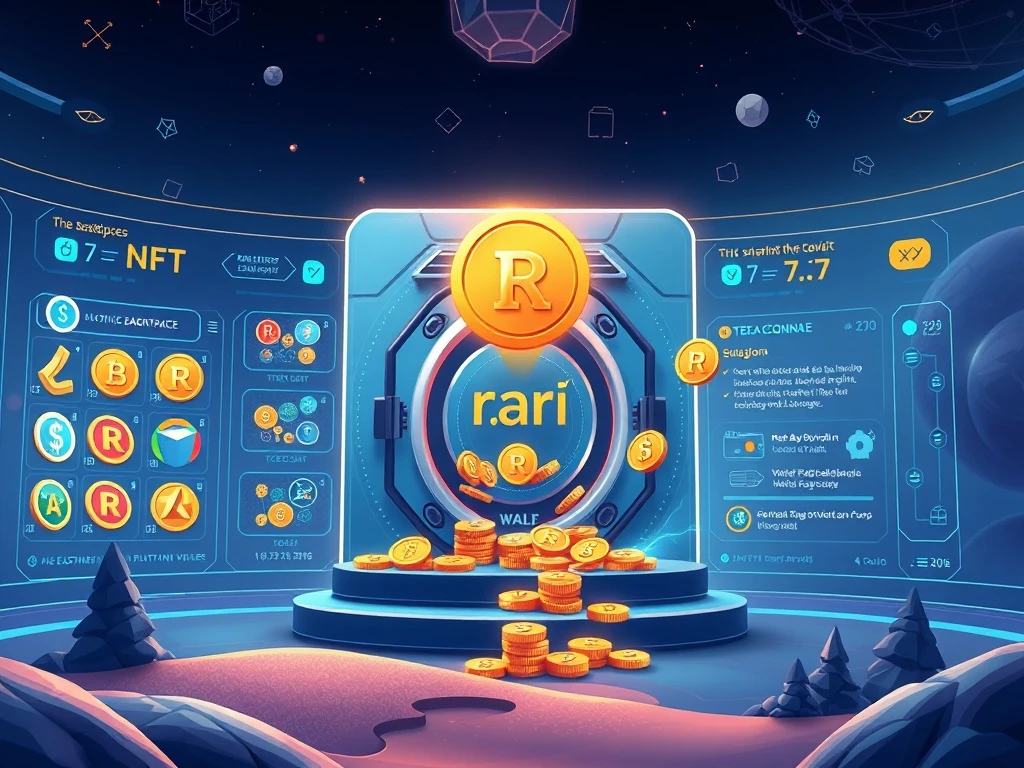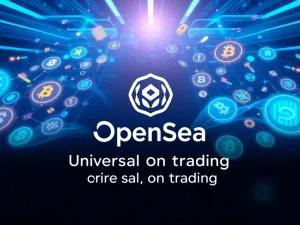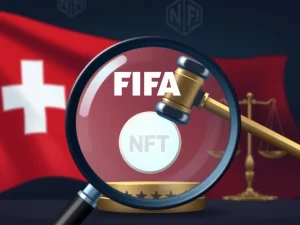Rarible NFT Marketplace Unveils a Pioneering Path to Sustainable NFT Growth

The dynamic world of non-fungible tokens (NFTs) constantly seeks innovative solutions for long-term viability. Today, the **Rarible NFT Marketplace** stands out, introducing a groundbreaking strategy. It aims to foster a truly **sustainable NFT** ecosystem. This approach moves beyond short-lived incentive schemes. It promises a more robust future for digital asset trading. For crypto enthusiasts, understanding these shifts is crucial. This initiative could redefine how NFT platforms operate and reward their communities.
Rarible NFT Marketplace: A New Era of Sustainable Rewards
The **Rarible NFT Marketplace** recently launched a significantly redesigned trading platform. This update brings a new system for transaction fees. Specifically, it directs these fees into strategic **token buybacks**. This model aims to provide a sustainable alternative. Earlier NFT marketplace incentive schemes often relied on fixed token allocations. These approaches proved unsustainable over time. Anna Riabokon, head of operations and governance at the RARI Foundation, explained the rationale. She stated, “Previous designs in the NFT marketplace ecosystem were not sustainable.” Riabokon emphasized their heavy reliance on unsustainable redistribution levels. These systems often dried up once token allocations were exhausted.
The new model fundamentally changes this dynamic. The RARI Foundation will now direct all revenue generated from platform transaction fees. This revenue goes “back into the hands of the traders.” This mechanism effectively creates a “fee-free” marketplace for active participants. It offers a unique value proposition. Traders receive benefits directly linked to platform activity. Consequently, this fosters a more engaged and loyal user base. The shift marks a significant evolution in NFT marketplace economics. It prioritizes longevity over fleeting hype.
Addressing Past Challenges in NFT Rewards Program Design
Many **NFT rewards program** iterations have emerged in the past. However, most faced significant challenges. They often struggled with sustainability and genuine market demand. Let’s examine some notable examples:
-
Blur’s Points System: In 2023, Blur rapidly gained market share. It used a points-based system. This system rewarded traders with future token airdrops. While it quickly attracted liquidity, it also had drawbacks. It fueled wash trading methods. Users repeatedly bought and sold NFTs to maximize airdrop rewards. This activity lacked genuine market demand. Ultimately, it distorted trading volumes.
-
LooksRare’s Token Emissions: NFT platform LooksRare adopted a similar strategy. It distributed its token to traders. This occurred as part of an emissions schedule. This model initially boosted volumes. However, much of the activity sharply declined. This happened once token rewards lost their value. Both examples highlight the pitfalls of incentive programs. These programs depend solely on fixed token distributions or speculative rewards.
These prior attempts underscore a critical lesson. An effective **NFT rewards program** requires a robust and self-sustaining economic engine. Simply distributing tokens without a clear value-generating mechanism leads to short-term gains. It rarely builds lasting communities or market stability. Rarible’s new strategy directly addresses these historical shortcomings. It aims to build a more resilient foundation.
The Strategic Shift: Embracing Token Buybacks for Stability
Rarible’s new approach centers on **token buybacks**. This mechanism is well-established in traditional finance. Companies often buy back their own shares. This reduces the outstanding supply. Consequently, it can increase the value of remaining shares. In the crypto world, this principle applies to tokens. Rarible is now applying this proven strategy to its RARI token. Transaction fees generated on the platform are used for this purpose. These fees directly fund the purchase of RARI tokens from the open market. This process creates constant buying pressure. It supports the token’s value. The acquired tokens are then redistributed to active traders. This ensures that rewards are directly tied to platform utility and activity.
This method differs significantly from past models. It does not rely on pre-allocated token pools that eventually deplete. Instead, it creates a circular economy. Platform activity generates fees. These fees then fuel buybacks. These buybacks, in turn, reward active users. This cycle is designed to be self-sustaining. It continuously recycles value within the ecosystem. The result is a more predictable and transparent reward system. This fosters genuine engagement rather than speculative farming. Ultimately, it supports a more **sustainable NFT** environment.
RARI Token: Fueling the Ecosystem and Community
The **RARI Token** plays a pivotal role in this new ecosystem. It is not merely a speculative asset. Instead, it acts as the primary vehicle for community incentives and governance. By directing transaction fees towards buying back RARI, the foundation reinforces its utility. This action creates a direct link between platform success and token value. As the Rarible NFT Marketplace thrives, so too does the RARI Token. Active traders receive RARI tokens as rewards. This encourages them to hold, stake, or use these tokens within the Rarible ecosystem. Furthermore, the RARI token grants holders governance rights. They can participate in key decisions regarding the platform’s future. This empowers the community. It aligns their interests with the platform’s long-term success. The token thus becomes a cornerstone of Rarible’s sustainable strategy.
The **token buybacks** mechanism impacts the RARI Token in several ways:
-
Reduced Supply: By purchasing tokens from the open market, the circulating supply can decrease. This creates scarcity, potentially increasing demand.
-
Increased Demand: The consistent buying pressure from the foundation provides a baseline demand for the token.
-
Value Redistribution: Rewarding active traders with RARI directly distributes value back to the most engaged community members.
This carefully designed system ensures the **RARI Token** remains central to the platform’s economic health. It incentivizes participation and ownership.
Beyond Trading Fees: The Power of Licensing Revenue
What truly sets Rarible apart from competitors is its diversified revenue stream. While many NFT marketplaces rely solely on trading fees, Rarible generates significant income from licensing its software. Anna Riabokon highlighted this unique advantage. She stated, “Unlike other marketplaces, Rarible generates revenue from licensing its software to brands such as Mattel and McFarlane Toys and over 40 other partners.” This distinct revenue source provides a stable financial backbone. It significantly bolsters the **NFT rewards program**. It also ensures the overall sustainability of the platform. This licensing model diversifies risk. It reduces Rarible’s sole dependence on volatile trading volumes. Therefore, the platform can support its community even during market downturns.
This licensing revenue directly contributes to the incentive program. It provides an additional, consistent funding source. This makes the entire system more robust. Riabokon reiterated this point. She explained, “By redirecting all revenue generated from trading into this incentive program, the system is inherently sustainable.” The combination of transaction fee buybacks and external licensing revenue creates a powerful, two-pronged approach. It ensures the longevity of Rarible’s community-centric initiatives. This dual revenue model is a critical differentiator. It positions Rarible as a leader in building a truly **sustainable NFT** ecosystem.
Ensuring Transparency for Sustainable NFT Growth
Transparency is paramount for building trust in any financial system, especially in decentralized finance. Rarible understands this critical need. The platform is committed to ensuring full transparency for its new incentive program. Riabokon confirmed that all payment of transaction fees occurs on-chain. This means every transaction is publicly traceable to the RARI Foundation treasury. This level of transparency allows anyone to verify the flow of funds. It ensures accountability. Furthermore, Rarible will provide leaderboards. These leaderboards will display the top participants in the incentive program. This adds another layer of openness. It allows traders to see how rewards are distributed. The RARI Foundation will also issue regular transparency reports. These reports will detail the program’s performance and financial health. This commitment to openness is crucial. It builds confidence among users. It fosters a healthy, **sustainable NFT** community. This proactive approach to transparency distinguishes Rarible. It reinforces its dedication to fair and equitable reward distribution. It ensures that the **Rarible NFT Marketplace** operates with integrity.
The Future of NFT Marketplaces: A Sustainable Path Forward
Rarible’s innovative strategy offers a compelling vision for the future of NFT marketplaces. By blending robust **token buybacks** with diversified licensing revenue, the platform addresses core industry challenges. It moves beyond the short-term speculative incentives that plagued earlier models. Instead, it cultivates a system designed for long-term growth and community value. This approach aims to create a truly **sustainable NFT** ecosystem. It benefits both traders and the broader platform. The **RARI Token** serves as the backbone of this economic model. It provides utility, governance, and a direct stake in the platform’s success. This holistic strategy positions the **Rarible NFT Marketplace** as a pioneer. It is setting new standards for how digital asset platforms can thrive.
The lessons learned from previous **NFT rewards program** failures are clear. Sustainability requires more than just distributing tokens. It demands a carefully constructed economic model. This model must generate value, redistribute it efficiently, and maintain transparency. Rarible’s new system embodies these principles. It offers a blueprint for other platforms seeking enduring success. The integration of licensing revenue provides a unique competitive edge. It ensures the platform’s ability to support its community through various market conditions. Ultimately, Rarible is not just redesigning its platform. It is redefining the very concept of a sustainable and rewarding NFT experience. This evolution could inspire a new wave of innovation across the entire Web3 space.








